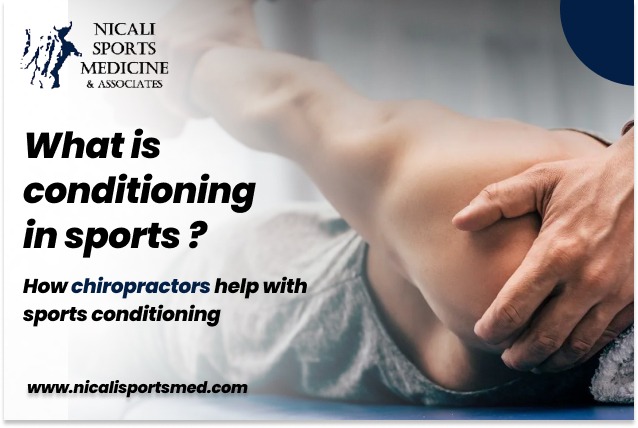What is meant by conditioning in sports?
Conditioning in sports is all about preparing athletes physically and mentally for fierce competition. It is more than just about building muscles. It’s about developing strength, speed, endurance, flexibility, balance, and coordination that is necessary to win sports. The aim of athletic conditioning is to improve performance. Also, it aims to reduce injuries via progressive training systems.
Unlike general fitness, sports-specific conditioning changes as per the movements, energy demands, and intensity of each sport.
For instance, football conditioning emphasizes explosive power, sprint intervals, and lateral agility, while a tennis player may focus on quick footwork, shoulder stability, and the capability to handle pressure. This type of training is rooted in conditioning exercises that are designed to simulate game-like conditions and assist athletes in facing fatigue, stress, and physical moves more effectively.
What is physical conditioning, and its types?
It’s essential to first understand the building blocks of conditioning before defining physical conditioning.
Types of physical conditioning:
- Aerobic conditioning: It improves the cardiovascular pressure handling to have better running and cycling.
- Anaerobic conditioning: It enhances the strength of mental or physical efforts that are used by a person, like HIIT and sprints.
- Muscular Strength and Power: It is essential to build explosive strength, like weight lifting and plyometrics.
- Flexibility and mobility: It increase the range of motion, like dynamic stretching and yoga.
- Neuromuscular coordination: It develops precise control over body movements, like balance drills or agility ladders.
- Core stability: It strengthens the midsection to make the spine secure to enhance movement and efficiency.
These factors work together in a system conditioning approach with programs specialized for athletic sports, goals, and levels.
Define what is meant by conditioning training?
Conditioning training includes the pattern routine and periodization to progress to increased intensity while preventing the feeling of tiredness.
- A well-designed training plan includes:
- Warm-up and mobility drills
- Strength and resistance training
- High intensity interventions
- Pressure control and stamina development
- Sports-specific drills aligned to the athlete’s position and role.
Students are taught the reasons for training body in body conditioning in physical education. It is essential for both sport and general wellness. It includes cardiovascular exercise, training to gain strength, flexibility, and movements from all the parts of body.
In football conditioning, the players go through an energetic routine to develop stamina. They work to gain more strength and sustainable power. It includes sled pushes, shuttle runs, cone drills, resistance, and band exercises to gain power. Training also stimulates match conditions by integrating drills. It includes route running, tackling and blocking to ensure athletes are ready physically and mentally.
Likewise, sports-specific conditions also include the following:
- Basketball: jump training, suicide runs, and lateral slides
- Soccer: sprint intervals, ladder drills, plyometric bounding.
- Track and field: tempo run, sprint mechanics, plyometrics.
- Combat sports: core endurance, footwork drills, bag conditioning.
The training styles are customized according to the energy systems and physical outputs of each sport.
Conditioning systems design: periodization and planning
A strong athletic conditioning system is about periodization, which means structuring training into progressive cycles.
- Macrocycle: full training year.
- Mesocycle: weekly to monthly, focus on specific goals.
- Microcycle: weekly and daily training sessions.
It makes sure that athletes learn at the right time. This avoids overtraining and manages fatigue effectively. For example, a Pleasanton fitness coach designs a conditioning training program that evolves from general prep to specific drills as the season nears. Such programs are common in high-performance training centers.
Why do chiropractors assist in sports conditioning?
At Nicali Sports Medicine and Association in Pasadena, CA, the chiropractic professionals play an important role in supporting athletes during every phase of sports conditioning journey. Here’s why chiropractors enhance performance and speedy recovery:
- Movement and postural Assessments: It evaluates the body moves and uncover problems such as imbalances, restricted joints, or faulty biomechanics that might hinder conditioning or it turn out to be the cause of injury.
- Spinal and joints adjustments: Improving spinal alignments makes nerves functioning in a much better way. Also, it improves the mobility, muscular activation, and conditioning more effective.
- Soft Tissues therapy: the myofascial release, massage, cupping, k laser therapy reduces soreness, increases blood flow, and process recovery.
- Integrated rehabilitation and pre-habilitation: With an active rehabilitation program, Nicali sports & med provides different types of exercise routines. It helps to prevent and recover from injuries which aids long-term conditioning.
- Performance at best level and injury hindering: Chiropractor at Nicali designs pre-habilitation plans to improve mobility and stability. It protects athletes from breaking down happening.
Conditioning and chiropractic therapy that athletes must try for the best performance
Professional and big athletes realize the value of combining conditioning training with chiropractor care.
By aligning spine and joint mechanics, the athletes say the following:
Professional and amateur athletes alike are realizing the value of combining conditioning training with chiropractic care. By aligning the spine and improving joint mechanics, athletes report:
The workouts help to:
- Improve balance and agility
- Correct injuries
- Improves energy and mental clarity
- The body works as a system under conditioning to work at its best level during sports.
That’s exactly what Nicali’s multidisciplinary team works as, blending chiropractor, physiotherapy, and conditioning as a driven plan.
Explanation of why sports conditioning and chiropractor care is important
If you are a seasoned athletes or a weekend warrior looking for personal records, the conditioning in sports remains important. For optimum performance the conditioning in sports is the foundation for the best performance during sports. It’s more than breaking a sweat that is true with sports conditioning.
The strategic planning together with progressive workload and mental resilience, is things gets from sports conditioning.
In order to define physical conditioning, it is a process of transforming the body into a resilient and efficient machine. With conditioning training, athletes build speed, power and endurance to flexibility, and agility. Whether it’s football conditioning, or body conditioning in physical education for general fitness, the general principle is same: train the body to meet the demands of sport. However, it is also true that people sometimes overlook the fact. Poor posture, muscle imbalance, and joint restrictions can ruin progress. It can increase the risk of injury or reduce the effectiveness of workouts. It also makes the chiropractor a game-changing player.
At Nicali sports medicine and associations, the athletes at all levels receive support and enhance conditioning programs. There is a combination that is used like sports specific conditioning, system conditioning, and active rehabilitation, which helps to align teams via spine and joint mobility support. It makes sure that every moment you take is efficient and safe.
The experts at Nicali helps to build a strong, mobile, and injury resistant body. It has world class sports medicine and active rehabilitation. The complete athlete’s focused solution combines strength, conditioning, and recovery.
Frequently Asked Questions
- What is kinesiology taping therapy and how does it work?
Ans: kinesiology taping therapy includes applying stretchy, skin alike adhesive tape that supports body muscles, joints and tendons without stopping movements. It works by lifting the skin microscopically with reduced swelling, enhanced blood and lymph flow. It also improves neuromuscular control. It is used in sports and rehabilitation settings to assist performance and recovery.
- Can kinesiology taping assist with knee pain or instability?
Yes, kinesiology taping is major for knee conditions like patellar tracking disorders, ligament disorder or runner knees that can provide both support and pain relief. It aids in stabilizing the kneecap and structures while allowing for full range of motion. It is perfect for athletes who wants to stay active during recovery.
- Is kinesiology taping effective for ankle sprains and achilles tendonitis?
Kinesiology taping ankle protocols are widely used for sprains, swelling and ligament support. For conditions like Archilles tendonitis, it reduces load on the tendon, with promoting circulations and speeding up healing. Its an excellent option for alongside that has
- Is kinesiology taping effective for ankle sprains and Achilles tendonitis?
Absolutely. Kinesiology taping ankle protocols are widely used for sprains, swelling, and ligament support. For conditions like Achilles tendonitis, taping can reduce load on the tendon, promote circulation, and speed up healing. It’s an excellent option to use alongside other rehab techniques or after an injury.
- Do I need kinesiology taping certification to apply the tape myself?
While self-application is possible, proper training improves results. Taking a kinesiology taping course or getting a kinesiology taping certification helps ensure you use the correct tension, placement, and tape pattern. At Nacali, our providers are certified and trained to apply taping safely and effectively for a wide range of sports injuries.
- Can kinesiology taping relieve shoulder or elbow pain, like in the rotator cuff or tennis elbow?
Yes, we regularly use kinesiology taping for rotator cuff injuries to support shoulder function and reduce inflammation. For kinesiology taping for tennis elbow, strategic taping decreases tension in the extensor muscles, providing relief during activity. Both applications are ideal for athletes involved in throwing, lifting, or racquet sports

